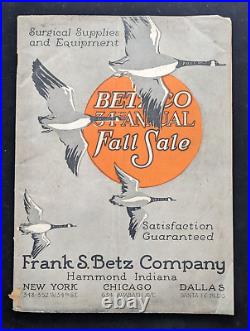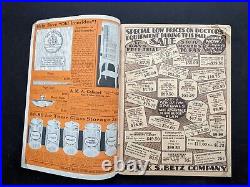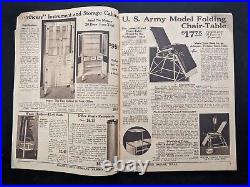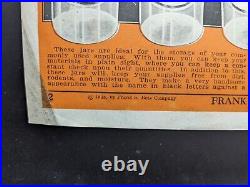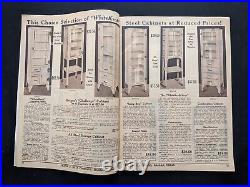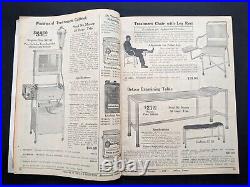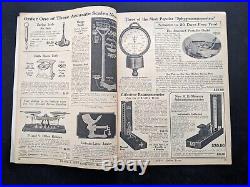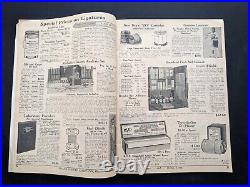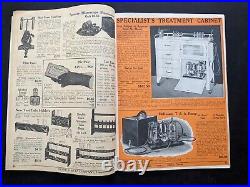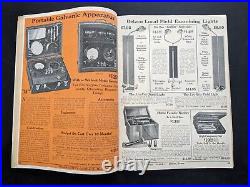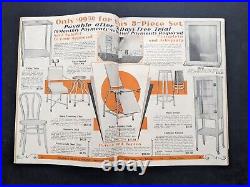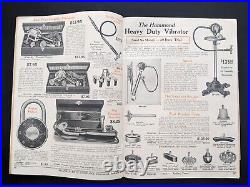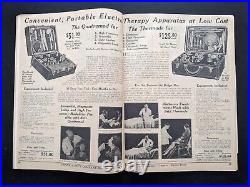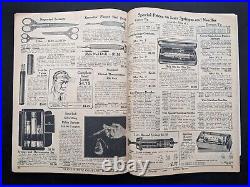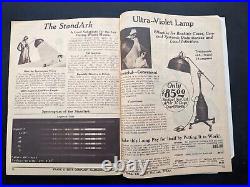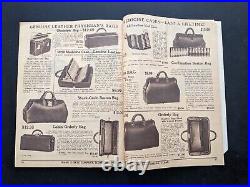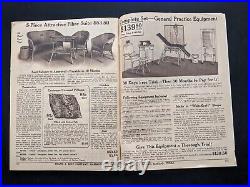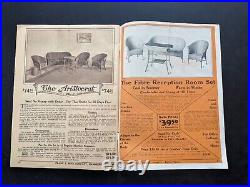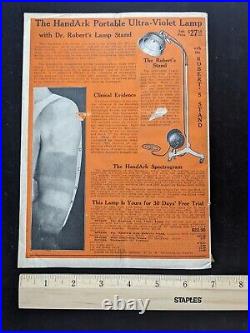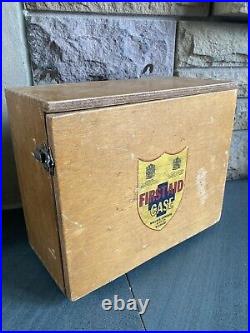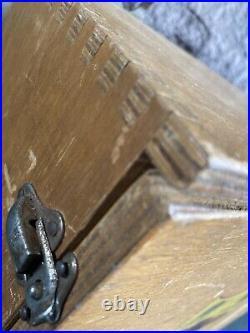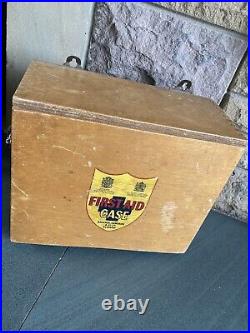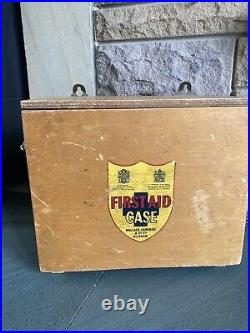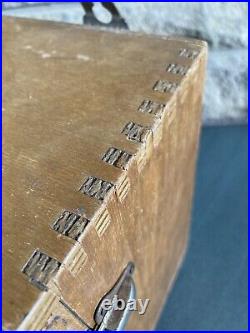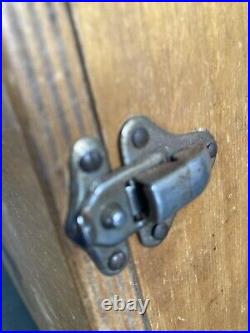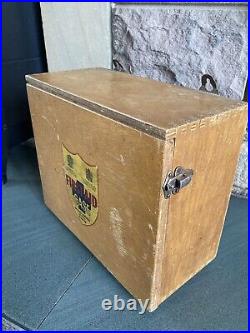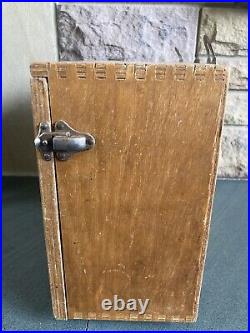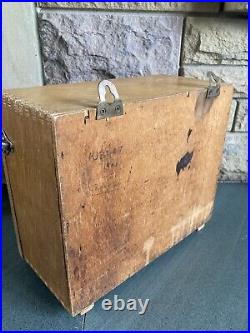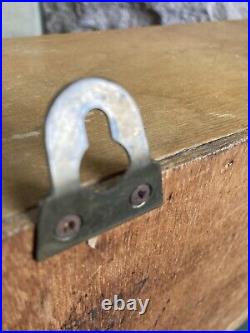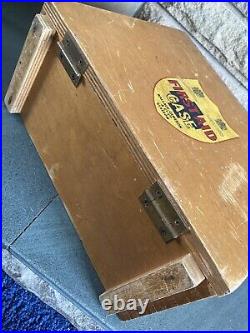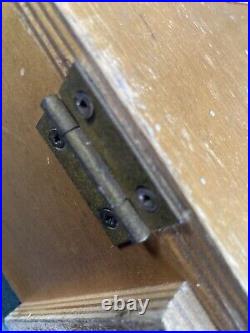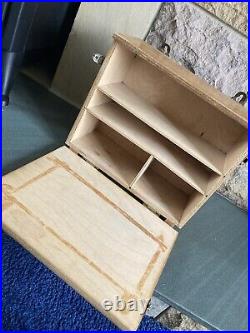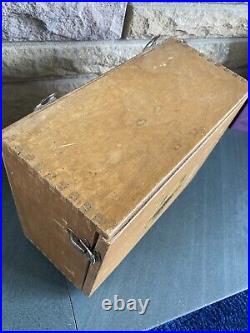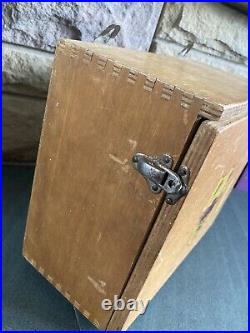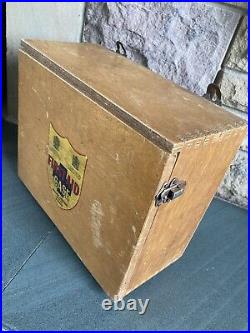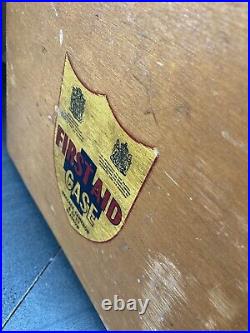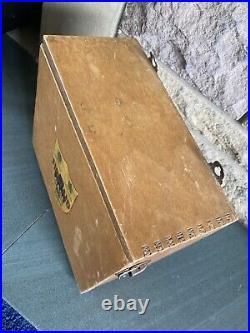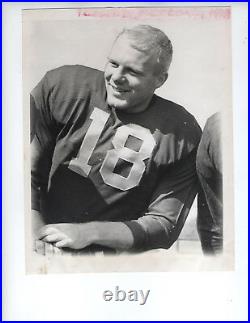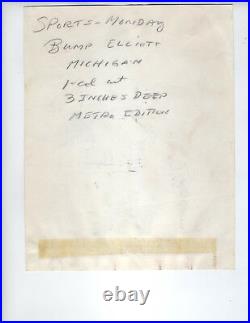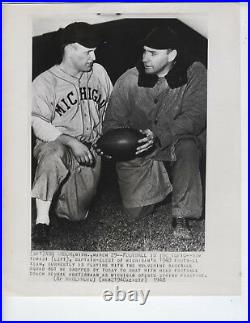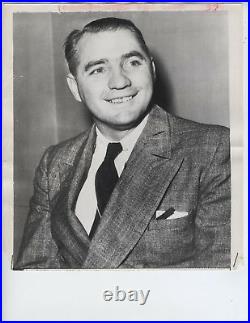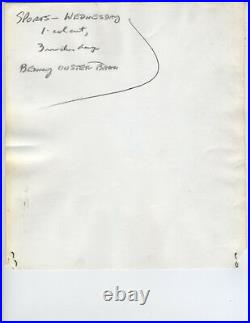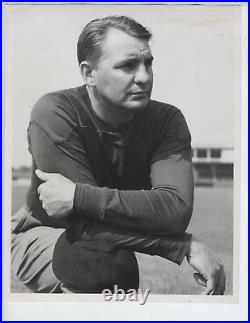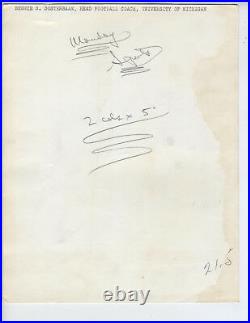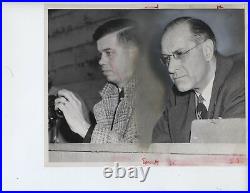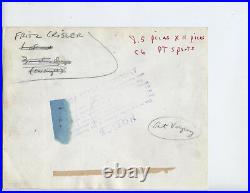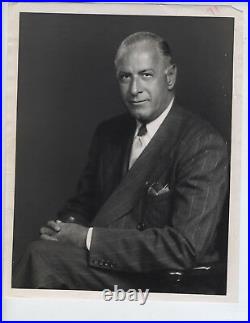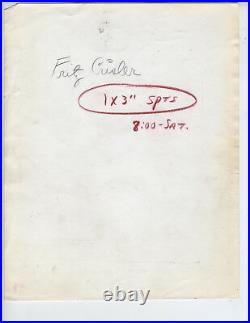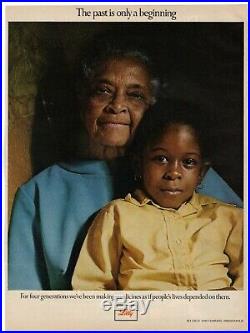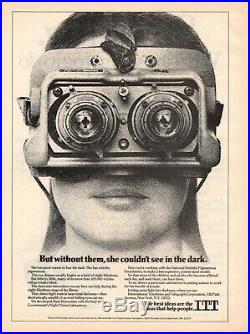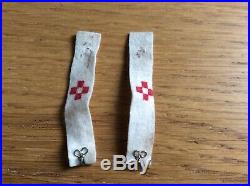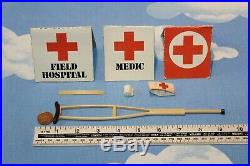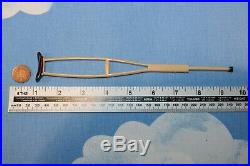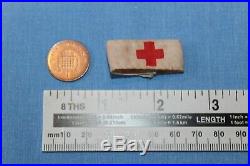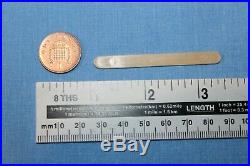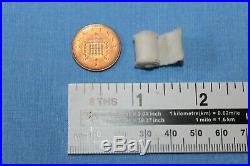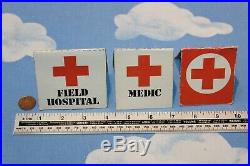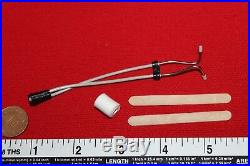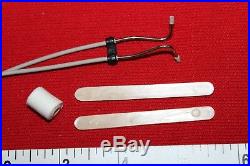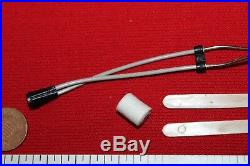A SIX vintage original photo collection from the University of Michigan football legends: (1) Bump Elliott measuring approx. 7×9 inches (2) Dom Tomasi & Bennie Oosterabaan approx. 8×10 inches (3) Bennie Oosterbaan approx. 8×9 inches (4) Bennie Oosterbaan approx. 8×10 inches (5) Fritz Crisler approx. 7×9 inches (6) Fritz Crisler approx. Herbert Orin “Fritz” Crisler (January 12, 1899 – August 19, 1982) was an American college football coach who is best known as “the father of two-platoon football, “[1] an innovation in which separate units of players were used for offense and defense. Crisler developed two-platoon football while serving as head coach at the University of Michigan from 1938 to 1947. Before coaching, he played football at the University of Chicago under Amos Alonzo Stagg, who nicknamed him Fritz after violinist Fritz Kreisler. During his 18-year career as a head football coach, Crisler’s teams won 116 games, lost 32, and tied 9. At Michigan, Crisler won 71 games, lost 16, and tied 3 for a winning percentage of. Crisler introduced the distinctive winged football helmet to the Michigan Wolverines in 1938. The Michigan football team has worn a version of the design ever since. Crisler had first introduced the winged helmet design at Princeton in 1935. [2] He was also the head basketball coach at Princeton for two seasons from 1932 to 1934, tallying a mark of 32-11. Crisler’s 1947 Michigan Wolverines football team, dubbed the “Mad Magicians, ” had an undefeated campaign, ending with a 49-0 triumph over the USC Trojans in the 1948 Rose Bowl. Afterwards, the team was selected the national champion by the Associated Press in an unprecedented post-bowl vote. Crisler retired from coaching after the 1947 season and served as the University of Michigan’s athletic director from 1941 to 1968. Crisler was also a member of the NCAA football rules committee for 41 years and its chairman for nine years. Crisler Center, home of the Michigan men’s and women’s basketball teams, was renamed in honor of Crisler in 1970. In addition, one “extra” seat in Michigan Stadium was added to honor Crisler for his special place in the history of Michigan football. However, its location is unknown. He participated in football at Mendota High School and was an outstanding student. [3] Articles in the October 7, 1915 and October 19, 1916 Sun Bulletins of Mendota, Illinois, show him to be a powerful football player who sent shivers up and down the spinal columns of the opposing team. Crisler enrolled at the University of Chicago on an academic scholarship with plans to become a doctor. [3] Crisler often told the story of his introduction to college football. Crisler recalled that he wandered over the football field as a freshman, where he saw the legendary coach Amos Alonzo Stagg directing a practice session. According to Crisler, Stagg knocked him over on the sideline while trying to get out of the way of an end sweep play. Stagg reportedly told the diminutive Crisler, If you’re going to play football, why don’t you put on a suit? Crisler worked out with the football team for a few days, but gave it up to return to his studies. When Stagg encountered Crisler a short time later on campus, Stagg said, I would have never picked you for a quitter. [3] Stagg was also responsible for Crisler’s nickname. After Crisler fouled up four consecutive plays during a practice session, Stagg told him, Crisler, from now on you are’Fritz’ after the master violinist. Not because you resemble him, but because you are so different. [3] Crisler played at the end position for Stagg’s Chicago Maroons from 1919 to 1921. In 1921, he was selected as a first-team All-American by Walter Eckersall, [4] a second-team All-American by Football World (based on a poll of 267 coaches), [5] and a third-team All-American by Walter Camp. [6] Crisler became an all-around athletic star at the University of Chicago, winning a total of nine varsity letters, three each in football, baseball and basketball teams. [7] Based on his achievements in multiple sports, Crisler was awarded the Big Ten Medal of Honor, one of the most prestigious conference awards in college athletics. Crisler remained an assistant coach at Chicago for eight years. [9] By 1925, he was also an assistant athletic director at Chicago and was reportedly being groomed to replace Old Man Stagg, when the veteran coach retires. [9][12] Crisler was the head coach of the Minnesota Golden Gophers football program for two seasons in 1930 and 1931. [13] In the 1930 season, Crisler’s team won three games, lost four and tied one. [14] Guard Biggie Munn was awarded the Team MVP Award. [15] In 1931, Crisler’s team improved to a record of 7-3. [14] Minnesota guard Biggie Munn was named a first-team All-American in 1931 and received the Chicago Tribune Silver Football as the most valuable player of the Big Ten. [16] Munn later became Crisler’s rival as the football coach at Michigan State University from 1947 to 1953. Two of his teams, the 1933 and 1935 teams, compiled perfect 9-0 records and were recognized by some as national champions. The 1933 team was invited to the Rose Bowl, but administration turned down the offer. Columbia, which has lost only one game, to Princeton, accepted the invitation and defeated Stanford. [17] Crisler introduced two innovations that later came into general usage. The first was his development of a faster starting stance for offensive linemen, and the second was a practice of having his quarterback stand apart from the huddle until ready to call a play. Crisler served as Michigan’s head football coach from 1938 to 1947. When he took over as head coach at Michigan in 1938, Crisler introduced the distinctive winged football helmet which has since become one of the symbols of Michigan Wolverines athletics programs. Crisler developed a similar winged helmet pattern in 1935 while coaching at Princeton. [18] At Michigan, he added to the innovation by painting the helmets maize and blue, thus highlighting the winged pattern. Crisler created the distinctive design to help his halfbacks find receivers downfield. Crisler later recalled, There was a tendency to use different colored helmets just for receivers in those days, but I always thought that would be as helpful for the defense as for the offense. [18] In his ten years as coach, the Wolverines compiled a record of 71-16-3. His Michigan teams finished lower than second in the Big Ten Conference only twice. The 1943 team won the school’s first Big Ten championship in ten years with an 8-1 record, losing only to Notre Dame, a game which would spark another 30 years of Michigan refusing to schedule a game against Notre Dame. His 80.5 winning percentage ranks him second in school history behind only Fielding H. Yost (minimum 50 games coached). [9] Crisler’s most noted players at Michigan included Heisman Trophy winner Tom Harmon, Bob Chappuis, Forest Evashevski (who later became athletic director at Iowa), Bump Elliott, Pete Elliott, Albert Wistert, Bob Westfall, Ed Frutig, and Julius Franks. [3] While coaching at Michigan, Crisler developed the platoon system in which separate groups play offense and defense. [1][19] He unveiled the system in 1945 in a game played at Yankee Stadium against Army. [20] Using a single wing formation, Crisler also conceived the buck lateral series and the spinning fullback play. [3] Crisler’s greatest success as head football coach at Michigan came with the 1947 Michigan Wolverines football team. The 1947 team, known as the “Mad Magicians” due to Crisler’s complex shifts, stunts, and schemes, [21] went undefeated and untied with a 10-0 record. Though ranked #2 in the Associated Press poll at the end of the regular season, the Wolverines defeated the USC Trojans by a score of 49-0 in the 1948 Rose Bowl game, and were selected as the nation’s #1 team by a 226-119 margin over Notre Dame in an unprecedented post-bowl Associated Press poll. The 1947 team has been selected as the best team in the history of Michigan football. [22] Led by team captain, Bruce Hilkene, quarterback Howard Yerges, and All-American halfbacks Bob Chappuis and Bump Elliott, the 1947 Wolverines outscored their opponents, 394-53. The Wolverines victory in the 1948 Rose Bowl tied Michigan’s final in the first ever 1902 Rose Bowl, as the most points scored, and the largest margin of victory, in the history of the “Granddaddy of Them All”. The 1947 Michigan team was also the first fully to embrace the concept of defensive and offensive specialization. Crisler established fully separate offensive and defensive squads. Only Bump Elliott and Jack Weisenberger played on both squads. In November 1947, Time magazine ran a feature article about the 1947 Wolverines (with Bob Chappuis’ photograph on the cover) called, The Specialist. [23] The Time article focused on the new era of specialization marked by Crisler’s decision to field separate offensive and defensive units. [23] The article noted: Michigan’s sleight-of-hand repertory is a baffling assortment of double reverses, buck-reverse laterals, crisscrosses, quick-hits and spins from seven different formations. Sometimes, watching from the side lines, even Coach Crisler isn’t sure which Michigan man has the ball. Michigan plays one team on offense, one on defense. Whenever Michigan’s defensive team regains the ball, Crisler orders:’Offense unit, up and out,’ and nine men pour onto the field at once. [23] One of the stars of the 1947 team, Dan Dworsky, went on to a career as an architect and designed Crisler Arena. Interviewed in 2007, Dworsky recalled: Crisler was not only an intellectual in strategy, but also in the way he ran practices. He ran practices rigidly and we called him’The Lord. He would allow it to rain, or not. He was a Douglas MacArthur-type figure, handsome and rigid. I sculpted him and gave him the bust in 1971. [21] Dworsky also kept another bust of Crisler in his office. Yost retired in 1941, and Crisler became the athletic director at that time. He continued to hold that position for 27 years until his retirement in 1968. [19] He was inducted into the College Football Hall of Fame in 1954. [1] During Crisler’s tenure as athletic director, the university’s athletic programs experienced a period of extraordinary success, in every branch of varsity sports. [20] The first expansion in 1949 involved the installation of permanent steel stands around the stadium concourse, increasing the seating capacity to 97,239. [32] In 1956, renovations expanded the seating capacity to more than 101,001. The 1956 expansion included 542 seats in a new communications center and 1,247 seats in a new press box. According to a newspaper article quoting an Athletic Department staff member, Fritz wanted to end up with a figure of 100,001, but he came up with a thousand seats too many. But he still got that 001 at the end. [32] Through subsequent renovations, Michigan has continued the tradition of ending official seating capacity numbers with the digit 1, and the final seat has been said to be reserved in Crisler’s honor. [3] With the success of the Michigan Wolverines men’s basketball under the leadership of Cazzie Russell, Crisler led the effort to build a new basketball arena in the mid-1960s. [3] The new arena was originally named the University Events Building. In February 1970, the arena was renamed Crisler Arena in honor of Crisler. [33] At the time of Crisler’s retirement in 1968, the Associated Press credited him with helping to lift college football from a’rah, rah’ campus pastime in the 1930s into the modern multimillion dollar enterprise of today. [3] Crisler was succeeded as Michigan’s athletic director by Don Canham, whom Crisler had hired as the school’s track coach in the late 1940s. [3] At the time of his appointment, Canham noted that replacing Crisler was a little like stepping up to bat after Babe Ruth. [34] Later years After retiring in 1968, Crisler continued to live in Ann Arbor. When Bo Schembechler took over as Michigan’s football coach in 1969, he recalled that he went out of his way to get to know Crisler. Schembechler considered Crisler “a giant” and made time to go over to Crisler’s house and sit in his basement, listening to Crisler’s theories and stories. [35] In 1978, Crisler and Fielding H. Yost became the first coaches inducted into the University of Michigan Athletic Hall of Honor; the only persons inducted ahead of Crisler and Yost were athletes, Gerald R. Ford, Bill Freehan, Tom Harmon, Ron Kramer, Bennie Oosterbaan, Cazzie Russell, and Bob Ufer. [36] He died in Ann Arbor in 1982 at age 83. He had been hospitalized twice in his final months, once for pneumonia. Michigan was a member of the Big Ten Conference during the Crisler years and played its home games at Michigan Stadium. During the 10 years in which Crisler served as head football coach, Michigan compiled a record of 71-16-3. Tom Harmon played for the Wolverines from 1938 to 1940 and in 1940 became the first Michigan player to win the Heisman Trophy. 1947 Michigan team, sometimes known as the “Mad Magicians”, compiled a perfect 10-0 record, outscored its opponents 394-53, defeated the USC Trojans 49-0 in the 1948 Rose Bowl game, and were selected as the nation’s No. 1 team by a 226-119 margin over Notre Dame in an unprecedented AP Poll taken after the bowl games. Bob Chappuis finished second in the Heisman Trophy voting in 1947. Ten players from the Crisler years have been inducted into the College Football Hall of Fame. They are Chappuis, Bump Elliott, Pete Elliott, Harmon, Elroy “Crazy Legs” Hirsch, David M. Nelson (inducted as coach), Tubby Raymond (inducted as coach), and Bob Westfall, Albert “Ox” Wistert, and Alvin “Moose” Wistert. Two have also been inducted into the Pro Football Hall of Fame-Hirsch and Len Ford. Three members of the coaching staff have also been inducted into the College Football Hall of Fame. They are Crisler, Clarence “Biggie” Munn, and Bennie Oosterbaan (inducted as player). Contents 1 Year-by-year results 2 Overview of the Crisler years 2.1 Harmon years 2.2 War years 2.3 Mad Magicians 3 Rivalries 3.1 Michigan State 3.2 Minnesota 3.3 Notre Dame 3.4 Ohio State 4 Coaching staff and administration 4.1 Assistant coaches 4.2 Others 5 Players 6 References Year-by-year results Season Head coach Conference Place Record PF PA 1938 team Fritz Crisler Big Ten Conference 2nd 6-1-1 131 40 1939 team Fritz Crisler Big Ten 3rd 6-2 219 94 1940 team Fritz Crisler Big Ten 2nd 7-1 196 34 1941 team Fritz Crisler Big Ten 2nd 6-1-1 147 41 1942 team Fritz Crisler Big Ten 3rd 7-3 221 134 1943 team Fritz Crisler Big Ten 1st (tie) 8-1 302 73 1944 team Fritz Crisler Big Ten 2nd 8-2 204 91 1945 team Fritz Crisler Big Ten 2nd 7-3 187 99 1946 team Fritz Crisler Big Ten 2nd 6-2-1 233 73 1947 team Fritz Crisler Big Ten 1st 10-0 394 53 Overview of the Crisler years Harmon years War years Mad Magicians Rivalries Michigan State Crisler is the only head coach in Michigan football history who served for more than two years and maintained an undefeated record in the Michigan – Michigan State football rivalry. Crisler compiled a perfect 8-0 record against the Spartans, including four shutouts in 1938 (14-0), 1942 (20-0), 1945 (40-0), and 1946 (55-0). [2] Biggie Munn, who was an assistant coach under Crisler from 1938 to 1945, served as head coach at Michigan State from 1947 to 1953 and as athletic director from 1954 to 1971. Minnesota During the Crisler years, Michigan compiled a 5-5 record in its annual Little Brown Jug rivalry game with the Minnesota Golden Gophers. [3] Minnesota defeated Michigan five straight years in the first half of the Crisler years. Under head coach Bernie Bierman, Minnesota compiled a nine-game winning streak over Michigan extending from 1934 to 1942. By the mid-1940s, with Bierman gone as head coach, the Golden Gophers fell from the top tier of teams, and Michigan concluded the Crisler years with five consecutive victories from 1943 to 1947. [4] During the Crisler years, the Little Brown Jug games often took on national significance, as the two teams came into several games ranked among the top teams in the country. Significant games include the following: In 1938, Minnesota was responsible for Michigan’s only loss in the first season under Crisler. The Golden Gophers won a close game by a score of 7 to 6. Minnesota and Michigan ended the 1938 season ranked #10 and #16 in the final AP poll. In 1940, Michigan and Minnesota were undefeated and ranked #2 and #3 in the AP poll before the game. Michigan took the lead on a touchdown pass from Tom Harmon to Forest Evashevski, but Harmon’s kick for the extra point went wide. Minnesota responded with its own touchdown and converted its extra point attempt to win the game by a 7-6 score. [5] Minnesota finished the 1940 season undefeated and with a national championship. Michigan was ranked #3 in the final AP Poll of 1940. In 1941, the teams were again undefeated heading into the game. Minnesota won the game 7-0. Minnesota went on to claim its second consecutive national championship, and Michigan was ranked #5 in the final AP poll. In 1947, the Wolverines were ranked #1 in the country and had averaged 55 points in the first four games of the season. The Golden Gophers gave the Wolverines the toughest game of the season. Michigan’s star back Bob Chappuis was held to 26 rushing yards, less than two yards per carry. [6] While the Wolverines won, 13 to 6, the close score resulted in Notre Dame moving ahead of Michigan to claim the #1 spot in the AP Poll. Notre Dame After a 30-year hiatus in the Michigan-Notre Dame football rivalry from 1910 through 1941, the two teams met in 1942 and 1943. In 1942, Notre Dame came into the game ranked #4 in the AP Poll, and Michigan was ranked #6. Michigan won the game, 32-20, in front of a capacity crowd of 57,500 at Notre Dame Stadium. Michigan’s total of 32 points was the most scored against a Notre Dame team since 1905. Michigan’s first touchdown came on a quarterback sneak by George Ceithaml from the one-yard line. Don Robinson ran for Michigan’s second touchdown on a fake field goal attempt, and Tom Kuzma scored two touchdowns in the second half. [7] In 1943, the teams came into the game with undefeated records and ranked #1 and #2 in the AP Poll. The highly anticipated game broke the Michigan Stadium attendance records with a crowd of 85,688. [8] The previous record was a crowd of 85,088 that attended the 1929 Michigan-Ohio State game. [9] Notre Dame won the game, 35-12. According to the United Press game account, the passing by Angelo Bertelli (1943 Heisman Trophy winner) caught the Wolverine secondary flatfooted and out of position repeatedly to make the rout complete. [10] The third quarter was marked by a malfunction of the electric clock, resulting in a third quarter that lasted 23 minutes. Notre Dame outscored Michigan 14-0 in the long third quarter. After nine plays had been run in the fourth quarter, the timing error was discovered, and an announcement was made over the stadium’s public address system that only two-and-a-half minutes remained in the game, as the fourth quarter was shortened to seven minutes. The only points in the short fourth quarter came on the last play of the game as Elroy Hirsch threw a 13-yard touchdown pass to Paul White. [11] Dame went on to win the 1943 national championship. After the 1943 game, the programs did not meet again until 1978. [12] Ohio State During the Crisler years, Michigan compiled a 6-2-1 record in the Michigan-Ohio State football rivalry. [13] Significant games during the Crisler years include: In 1939, Ohio State came into the game ranked #6 in the country with Michigan unranked and having two losses. The Wolverines upset the Buckeyes, 21-14. In 1940, the game marked the final college football game to be played by Tom Harmon after three brilliant years for the Wolverines. Michigan defeated Ohio State 40-0. Harmon ran for three touchdowns, threw two touchdown passes, and converted four PATs. He also averaged 50 yards per punt on three punts. When Harmon left the field with 38 seconds remaining, the crowd in Columbus gave a standing ovation to a Michigan football player. [14] In 1942, the teams came into the game ranked #4 and #5 in the AP poll. The Buckeyes won the game, 21 to 7, in Ann Arbor. [15] The victory over the Wolverines helped propel Ohio State to the #1 spot in the final AP Poll, as Ohio State won its first national championship. In 1944, Ohio State came into the game ranked #3 and undefeated. Michigan was ranked #6 and had one loss. The Buckeyes defeated the Wolverines, 18-14, in Columbus. Ohio State narrowly missed its second national championship, being ranked #2 in the final AP Poll. In 1945, both teams were ranked among the top ten in the AP Poll, and Michigan won, 7-3. George Ceithaml 1940 1942 Quarterback All-Big Ten quarterback, 1942; Crisler called him “the smartest player he ever taught”; served as an assistant coach at Michigan and USC Bob Chappuis 1946 1947 Halfback Shot down over Italy in World War II; All-American and 2nd in Heisman Trophy voting (1947); played for Brooklyn Dodgers (AAFC) (1948) and Chicago Hornets (1949) Bill Daley 1943 1943 Fullback All-American, 1943; Played for the Brooklyn Dodgers (AAFC) (1946), Miami Seahawks (1946), Chicago Rockets (1947), and New York Yankees (AAFC) (1948) Fred Dawley 1939 1941 Fullback Played for the Detroit Lions (1944) and Los Angeles Bulldogs (1945) Robert Derleth 1942 1946 Tackle Played for the Detroit Lions (1947) Gene Derricotte 1946 1948 Halfback, Quarterback Served as a Tuskegee Airman during World War II; holds Michigan’s single season record for punt return average Wally Dreyer 1943 1943 Halfback Played for Chicago Bears (1949) and Green Bay Packers (1950); head football coach for the University of Wisconsin-Milwaukee Panthers. Dan Dworsky 1945 1948 Fullback, Center, Quarterback Played for the Los Angeles Dons (1949); later became an architect and designed Crisler Arena and Drake Stadium (UCLA). Coach at Michigan for 10 years Len Ford 1945 1947 End Played 11 years in the AAFC and NFL with the Dons, Browns and Packers; inducted into the Pro Football Hall of Fame in 1976 Julius Franks 1941 1942 Guard First-team All-American 1942; Michigan’s first African-American All-American Ralph Fritz 1939 1940 Guard Played 1 year in the NFL for the Eagles Ed Frutig 1938 1940 End First-team All-American 1940; Played 3 years in the NFL with the Packers and Lions Elmer Gedeon 1936 1938 End Played baseball for the Washington Senators; one of two MLB players killed in action during World War II after being shot down while piloting a B-26 bomber in 1944 John Ghindia 1947 1949 Quarterback, Fullback, Halfback Starting quarterback on the 1949 Michigan Wolverines football team that finished the season ranked No. 7 in the country; later served as a high school football and tennis coach in Wyandotte and Ecorse, Michigan. John Greene 1940 1943 Tackle, Quarterback Later played 7 years in the NFL with the Lions Tom Harmon 1938 1940 Halfback 1940 Heisman Trophy winner Ralph Heikkinen 1936 1938 Guard All-American 1939; MVP of the 1937 and 1938 Michigan football teams; Played 1 year in the NFL for the Brooklyn Dodgers Bruce Hilkene 1943 1947 Tackle Captain of the undefeated 1947 Michigan team known as the “Mad Magicians” Elroy “Crazy Legs” Hirsch 1943 1943 Halfback Only Michigan athlete to letter in football, baseball, basketball and track in the same year; Played 12 years in AAFC and NFL for Rockets and Rams; Inducted into College (1974) and Pro Football Hall of Fame (1968). Bob Hollway 1947 1949 End Later served as head coach of the St. Farnham Johnson 1943 1943 End Later played with the Chicago Rockets of the All-America Football Conference in 1948. Jack Karwales 1941 1942 End, tackle Later played professional football for theChicago Bears in 1946 and for theChicago Cardinals in 1947. Truman in 1950 Fred Negus 1943 1943 Center Later played pro football for the Chicago Rockets and Chicago Bears David M. White 1946 1947 Center 2nd team All-American 1947; Played for Big Ten championship teams at Michigan (1947) and Ohio State (1942); Later served as an assistant coach and assistant athletic director at Penn State Paul White 1941 1946 Halfback Played 1 year in the NFL for the Steelers Bob Wiese 1942 1946 Fullback, Quarterback Played 2 years in the NFL with the Lions F. Cloud State Al Wistert 1940 1942 Tackle All-American, 1942; MVP 1942 Michigan team; Inducted into College Football Hall of Fame, 1967; His No. 11 is 1 of 5 retired numbers at Michigan; Played 9 years in the NFL for the Steagles and Eagles; 8-time All-Pro Alvin Wistert 1947 1949 Tackle All-American, 1948 and 1949; Inducted into College Football Hall of Fame, 1967; Oldest college football player ever selected as an All-American at age 33; His No. 11 is 1 of 5 retired numbers at Michigan Irv Wisniewski 1946 1949 End Later coached football and basketball at Hillsdale College and the University of Delaware Howard Yerges 1944 1947 Quarterback Played for Ohio State in 1943; Quarterback of the undefeated 1947 team known as the “Mad Magicians”; All-Big Ten 1947 Fritz Crisler, athletic director of the University of Michigan. Crisler is a life member of the Rules Committee. Seldom celebrated in headlines as a mover and shaker in college football circles, he has, in his quiet, behind-the-scenes way, exerted a profound influence on the game. In Fort Lauderdale, Fla. Where the deep thinkers of the committee saw the error of their ways and came, at last, almost full circle to the free-substitution rule of the late’40s, in the background, as insistent as ever, was the voice of Fritz Crisler. Crisler has always been thinking a little ahead of his colleagues. He urged the adoption of the first unlimited-substitution rule as a wartime measure in 1941. He had been the first to suggest the conversion option that gave a team the choice of kicking for one point after a touchdown or running or passing for two. He had championed wider goal posts to encourage more tries for field goals. Some little time before leaving Ann Arbor for this year’s rules meeting, Crisler had gone on record as favoring the return to unlimited substitution. He had gone on record with some other ideas in response to a suggestion that he observe his 25th anniversary at Michigan (and his 65th birthday) by taking a look back over the years and into the future of the game to which he has devoted his life. I met Crisler in his ground-floor office in the Michigan athletic administration building. He stood near his desk, tall, broad of shoulder, trim of waist. When he walked to a window and back again, as he occasionally did, he was quick and sure in every movement. His eyes were clear and cool, his face unsmiling, as he considered how he would begin. Behind him was one of the greatest coaching careers in the history of college football. He had started as an assistant to the incomparable Amos Alonzo Stagg at the University of Chicago; he had moved on his own to Minnesota, Princeton and Michigan. As head coach, he had a lifetime record of 116 victories, 32 defeats, nine ties. His magnificent 1947 team had gone through the season undefeated and then had scored a 49-0 victory over Southern California in the Rose Bowl. It was the last team he coached before he retired, as Coach of the Year, to devote all his time to the athletic directorship, a new career during which Michigan Stadium was twice expanded, until it became the largest college-owned bowl in the country, with a seating capacity of 101,001. He sat down at his desk, leaned forward and rested his elbows on it. “Now, ” he said, about the substitution rule. Let’s go back and review the circumstances that made platooning possible. World War II had created a tremendous drain on manpower, and in the 1941 meeting of the Football Rules Committee many people felt that football schedules should be scrapped entirely. But the services urged that the colleges continue all athletic programs as best they could, pointing to their importance in conditioning the boys who would eventually be called up and to the morale and leadership factors involved. With this directive from the services, the Rules Committee met to ponder the question-the staggering question-of how we were to continue with our ranks so depleted. I attended that meeting in my capacity as president of the American Football Coaches Association, along with Matty Bell of Southern Methodist, who was to succeed me in that office. We had no vote, but we could have the floor at any time and state our views. Since the problem was obviously a matter of depth, Matty and I came to the conclusion that the answer might be found in a relaxation of the substitution rule. The rule at the time said that if a boy started a quarter and was taken out he could not return to the game during the same quarter. So if you had only a limited number of men, a narrow bench, and you had to make substitutions for reasons of injury or fatigue, and one thing and another, you might very well run out of men altogether. The Rules Committee found the answer in three little words. Instead of having the rule say that a substitute could enter the game only once in a quarter, the committee approved a rule permitting a substitute to enter the game’at any time. Just those three little words. And those three little words made platooning possible? Actually, ” said Crisler, “they did. But at the time our concern was for the single boy. We were thinking of the single boy who might have to be taken out briefly. We wanted to be able to put this boy back in the game as soon as he was ready and needed. I don’t think anybody at the 1941 meeting of the Rules Committee visualized platooning as it was later developed. What made him decide to go to platooning in 1945? You see, almost all colleges were playing freshmen at the time, because the older boys were in the service. Now, before the Michigan-Army game I figured that I would have to start nine freshmen against Red Blaik’s great Blanchard-Davis team. By comparison with Michigan, Army had a team of mature men. I asked myself,’How are our poor, spindly-legged freshmen going to stand up against these West Pointers all afternoon? I knew I would have to spell them off during the game. So I picked our best defensive men and said,’When we lose the ball, you fellows automatically go in. Then I got my best offensive men and ball handlers together and said,’When we regain possession, you fellows automatically go in. As it turned out, I only platooned the lines, and the linebackers on defense. We lost the game 28-7, but it should have been much, much worse. I remember very well that after the game my telephone rang constantly. Coaches were asking me,’What’s it all about? What are you up to? A few coaches tried platooning that very season, next year Army went to it and practically everybody else followed suit. By 1953, did he consider that platooning had gone too far? Did he lead the move to kill it entirely? “No, I did not lead it, ” said Crisler. That’s an erroneous thing. The fact is that as chairman of the Rules Committee in 1953 I had two concerns. One, 50 colleges had given up football in 1952, on the ground that they could not afford the cost of recruiting so many men. Two, I had been getting protests from young men who had gone into coaching. They told me they knew how to coach only one kind of football-offensive or defensive. One young man said,’I don’t know what to do on offense because I never played it. So, taking these two points into consideration, I went into the meeting feeling that we should not go any further in relaxing the substitution rule. As a matter of fact, there was only one further step you could take and that would be to permit free and unlimited substitution any time, the clock running or the clock dead, as in the professional game. I felt that we should either hold the line or tighten up a bit. But then, to my utter amazement, there was a strong sentiment in favor of going back all the way, essentially to the rule as it was before 1941. This body of opinion was led by General Bob Neyland of Tennessee. He felt most strongly about it. He thought the game was being hurt. I took the position that since we had evolved by steps, we should go back by steps. For one thing, we had all these coaches who had not played under the old rules. But, strangely enough, the committee went all the way with General Neyland and those who shared his opinion. The free-substitution rule was killed, and the platoon with it. What did Fritz Crisler think the Rules Committee should do about the substitution rule this year? On the eve of the annual meeting, he leaned back and thought a moment. Of course, as a life member of the committee I have no vote. But I might say that I think the 1946 rule was a very good rule. I think there might be real merit in considering a return to that rule. The 1946 rule permitted free and unlimited substitution whenever the clock was dead for any reason. It also put a limit on time-outs. The recently adopted new rule permits unlimited substitution with one restriction: a team must sacrifice a time-out when it sends in a platoon during the progress of a period when the clock is running. Coaches say that this restriction will mean that they will have to continue development of some “two-way, multitalented” players rather than depend entirely on offensive and defensive specialists. Crisler did not agree with people who believe the college and professional games should be exactly the same. There are a number of differences between the college and professional games. In addition to the substitution rules, there are also the width and position of the goal posts and, in the NFL, the try for points after touchdowns. Obviously there are differences in the ages, the weights and the quality of players. No reason why they should be the same. As for the college game, I would like to see a lot of different formations and a wide variety of plays. For instance, when Don Faurot developed the split T at the University of Missouri he was widely copied. Bud Wilkinson developed it with great success at Oklahoma. Then the little variations came in, with split end and slot back and so on. Today we have a climate, an atmosphere, of copying rather than inventing. In a moment he went on: I remember the old plays. The hurry-up huddle, the sideline and talking plays. Our defense against the sleeper was rather celebrated. The sleeper was banned by the Rules Committee, but when the play was legal a man could hide out over where there were substitutes standing or where there was a crowd on the sidelines. You would tell your halfbacks,’Scan your sides of the field after every play to look for that sleeper. You would say to your safety,’You scan both sides. Despite their vigilance, the boys would frequently miss a sleeper hiding out. Finally we thought of adding a bugler to our defense. The kind of bugler who blows a horn? That kind of bugler. We would put a bugler up on top of the press box with instructions to watch for that sleeper, and when he spotted one to blast out reveille with all the fervor and wind that was in him. It worked, but we could only use him at home games. There was a limit on the number of men we could take on a trip. One time we went to Illinois, and Zup [Coach Bob Zuppke] laid a sleeper out there and beat us with the play. If we had had our bugler I don’t think Zup would have beat us. The scene shifted to the den in Crisler’s home. The walls were filled with photographs of his teams at Minnesota, Princeton and Michigan. There were several photographs and sketches of “the Old Man, ” as Crisler affectionately refers to Amos Alonzo Stagg, his patron at the University of Chicago, now in Stockton, Calif. In his 101st year. Crisler’s eyes lingered on the pictures of Stagg. “It is a strange feeling, ” he said quietly, to look back and see where some trivial incident changed the whole course of your life. He sat back in his chair, the memories crowding in on him. “I was born, ” he said, on a farm in Earlville, a village about 70 miles west of Chicago. I was christened Herbert Orin Crisler. Coach Stagg fastened the nickname of’Fritz’ on him after he had fumbled three times in a row. Stagg made the sarcastic point that there was a violinist, a great artist, who spelled his name Kreisler. He said he was naming Crisler Fritz because he bore absolutely no resemblance to Fritz Kreisler, the artist. I was a skinny kid. I didn’t weigh more than 100 pounds when I entered high school. I concentrated on my studies and, with an average of 93.4, I applied for an academic scholarship at the University of Chicago and I was awarded one on the basis of my scholastic record. I enrolled as a pre-med, and it was during my freshman year that this trifling incident occurred that changed the course of my life. Before the incident I have in mind I had stopped one day to watch football practice. A play headed in my direction. Stagg, back-pedaling away from the play, bumped into me and we both went down. As we picked ourselves up, he saw, by my cap, that I was a freshman and so he said,’Why aren’t you out for freshman football? I had gained some weight by that time, but I told Mr. Stagg I had never played football. He said,’You ought to be out anyway with the rest of your classmates. So I reported next afternoon, got a uniform, and Pat Page, the freshman coach, put me in scrimmage. I took a terrible pounding. That evening I turned in my uniform. About 10 days later I was crossing the quadrangle and I saw Mr. Stagg coming along on his bicycle. I ducked my head, but he spotted me and stopped. He said,’Weren’t you out for football? I said I had been, but I had quit because I didn’t know anything about the game. I’ll never forget the look of scorn Mr. Well,’ he said, I never thought you’d be a quitter! Crisler shook his head and smiled. “Of course, ” he went on, I said to myself,’I’ll show you. I went back out the next day and I was off on an athletic career that brought me nine letters at Chicago. I was a pitcher in baseball, a standing guard in basketball, an end in football. But if the Old Man hadn’t come riding by on his bike at that precise moment that day, I wouldn’t be sitting here now with all these pictures and souvenirs and mementos on the walls. The walls reflected a career that is the Great American Dream as it is cherished by young men who enter the profession of football coaching. At 25 he was offered the head coaching job at Minnesota. He asked his mentor for counsel, and Stagg said, Fritz, you’re not ready to fly. ” When Minnesota came after him again six years later and this time wanted him to be athletic director as well as head coach, the Old Man said, “Now you’re ready to fly, Fritz. And go to it he did. At Minnesota, Crisler won 10, lost seven and tied one. When he moved to Princeton, as the first non-alumnus ever to coach in the Big Three, he ran up a record of 35-9-5. At Michigan, from 1938 to 1948, Crisler-coached teams won 71 games, lost 16 and tied three. “In every move I made, ” said Crisler, there was only one way you could go-up. Minnesota had had bad seasons. Princeton and Michigan as well. He got up and looked at the photograph of his 1947 undefeated Michigan team, the 49-0 Rose Bowl victors. They were a marvelous bunch of kids. A coach gets a group like that every once in a lifetime. Some never get one. Greatest bunch of ball handlers I ever saw. The offensive line averaged only 188. Today they don’t recruit tackles unless they weigh 230. Was it true that the lighter teams were not as injury-prone as those of today? “I don’t know, ” said Crisler, if that was because they were light or not. I have the feeling that it is contributing to injuries. The equipment was supposed to protect the wearer from injury, and now I’m wondering if it isn’t causing injuries. I would like to see a rule on the subject of equipment-the face mask, the headgear, this unyielding armor we’re putting these kids into. I’ve declared myself. You see, you get the depth of this unyielding plastic in the back of the neck and you get this face mask out front. A blow of some sort underneath the mask can cause a whiplash in the back of the neck, in the area of the cervical vertebrae. A blow of this kind could be fatal. It has been fatal. There is also the danger that, with grasping the mask itself, you will get a sharp head rotation and a disabling injury. There is another serious point to be made in this same connection. The face mask and headgear are changing the mechanics of football, and blocking in particular. Now they’re blocking with the head. The shoulder blocks and side body blocks are gradually disappearing. This use of the headgear as a weapon is called spearing. They have spearing drills. Some call it goring. Now, if you took the face mask off, it isn’t likely that they would be able to do that sort of thing. The 1964 Rules Committee meeting voted to make it a personal foul for a player to ram an opponent in the head, face or neck with his helmet or neck. Nothing was said about changing the helmet or removing the mask, as Crisler so strongly recommends. Was anything being done about that problem? “There are a number of studies going on, ” said Crisler. Here at Michigan, Bennie Oosterbaan [Michigan's famous All-America end and former coach] and I have been assisting Dr. Richard Schneider, a great neurosurgeon, by getting films together for his study of football fatalities. There is conclusive evidence that with today’s helmet and face mask you get that whiplash I mentioned. Without the face mask, wouldn’t there be some teeth knocked out, some noses broken? Crisler looked around the walls, his eyes lingering a moment on one of the portraits of Stagg. “I would rather have that, ” he said quietly, than to see a boy on a slab in the morgue. Later on, Fritz Crisler conducted a tour of Michigan Stadium. Outside the great bowl there is a sign that reads simply, Michigan Stadium. Under Fielding Yost, whom Crisler succeeded as athletic director, the stadium’s capacity was 79,000. Crisler is obviously proud that the University of Michigan has the largest college-owned stadium in the U. He would not concede that it is his personal monument, although that is what many people consider it to be. One question that all Crisler’s guests ask him is, How did you arrive at a seating capacity of 101,001? Was it pure coincidence? Was there a reason for the additional seat? Crisler smiles at the question. Let us put it this way. It makes a great conversation piece at cocktail parties. That extra seat had no significance of any kind? It was not any special seat in any special spot? “It has its spot, ” said Crisler. And he would not tell? Fritz Crisler leaned back against a goal post and gazed around the stadium and down the snow-covered field. He smiled and shook his head. It was his secret. Perhaps it is reserved, now and forever, for someone who taught Fritz Crisler a way of coaching football and a way of life. For the Old Man, Amos Alonzo Stagg. “Bump” Elliott (born January 30, 1925)[1] is a former American football player, coach, and college athletics administrator. Elliott grew up in Bloomington, Illinois, enlisted in the United States Marine Corps as a senior in high school and was assigned to the V-12 Navy College Training Program at Purdue University. He received varsity letters in football, baseball, and basketball at Purdue, before being called into active duty in late 1944, serving with the Marines in China. After being discharged from the military, he enrolled at the University of Michigan in 1946 and joined the football team for whom his brother Pete Elliott played quarterback. In 1947, he played for an undefeated and untied Michigan football team known as the “Mad Magicians”, led the Big Nine Conference in scoring, won the Chicago Tribune Silver Football trophy as the Most Valuable Player in the Conference, and was selected as an All-American by the American Football Coaches Association. After graduating from Michigan in 1948, Elliott spent ten years as an assistant football coach at Oregon State, Iowa, and Michigan. He was appointed as Michigan’s head football coach in 1959 and held that position until 1968, leading the team to a Big Ten Conference championship and Rose Bowl victory in the 1964 season. For a period of 21 years, from 1970 to 1991, he was the athletic director at the University of Iowa. During his tenure as athletic director, he hired coaches Dan Gable, Hayden Fry, Lute Olson, C. Vivian Stringer, and Dr. Tom Davis, and the Iowa Hawkeyes won 41 Big Ten Conference championships and 11 NCAA titles. In 1989, Elliott was inducted into the College Football Hall of Fame. Contents 1 Early life 2 Purdue University and military service 3 University of Michigan 3.1 1946 season 3.2 Big Nine MVP in 1947 3.3 1948 Rose Bowl against Southern Cal 3.4 Application for 1948 eligibility denied 4 Coaching career 5 Athletic director at Iowa 6 Family 7 Honors and accolades 8 Head coaching record 9 See also 10 References 11 External links Early life Elliott was born in Detroit, but grew up in Bloomington, Illinois. [2] His father, Dr. Norman Elliott, was an ears, nose and throat doctor who also coached football at Illinois Wesleyan University from 1930 to 1934. [3] Elliott’s given name is Chalmers, but he has been known by the nickname “Bump” since he was six months old, though nobody remembers how he got the nickname, not even his mother. [4] Elliott and his younger brother, Pete Elliott, both played football together for Bloomington High School, where Bump was an All-State halfback in 1942, and Pete made it as a fullback in 1943. [5] Had it not been for World War II, Bump and Pete likely would have attended the University of Illinois, which was about 50 miles from their home in Bloomington. However, both brothers wanted to get into the V-12 Navy College Training Program, and Illinois did not have such a program. [5] Bump enlisted in the United States Marine Corps while still a senior in high school and was called to active duty in 1943. He was assigned to the V-12 officer training program at Purdue University. [6] His brother, Pete, also enlisted and was assigned to officer training at Michigan. In his freshman year, Elliott earned varsity letters in football, basketball and baseball. He played three games for the unbeaten and untied 1943 Purdue football team where he was described as a capable triple-threater and stellar defensive performer. [7] He scored a touchdown against Minnesota in his first game, [8] and made a key interception at Purdue’s ten-yard line in the season’s final game against Indiana. [9] A May 1944 newspaper article reported that the 19-year-old Elliott, who had been a “high school sensation last year, “[10] had won three major athletic letters in his first year as a Naval V-12 student at Purdue. A speedy 160-pound, five foot 10-inch performer, he lost little time making his mark in football last fall once he became eligible upon completion of his first V-12 term. “[10] Elliott appeared in the final three games of the football season, and his performance in the season’s final game against Indiana “provided one of the highlights of the Boilermaker season. “[10] In basketball, he was “consistent as a guard on Purdue’s cage combination. “[11] In baseball, Elliott played shortstop and center field, where he was “a steady fielder with a strong arm. [10] In a May 1944 game, Elliott led the Boilermakers to a 17-4 win over Wisconsin, with five hits, five stolen bases, four RBIs, three runs scored, and four putouts in center field. His performance against Wisconsin was “one of the biggest baseball days ever turned” by a Big Ten baseball player. [12] Elliott played in the first six games of the 1944 football season for Purdue before being transferred by the Marine Corps. In a game against Marquette in late September, he broke up a 7-7 tie with successive touchdown runs of 24 and 71 yards. [13] He was also the only defensive player in 1944 to pull down Illinois’ Claude “Buddy” Young from behind. [14] Elliott received orders to report for active duty in October 1944, and he played his last game in a Purdue uniform against the Michigan Wolverines on October 28, 1944. [6] In November 1944, Elliott was sent to Parris Island. He was later sent to China and emerged from the war as a Marine lieutenant. [15] University of Michigan Elliott and his younger brother, Pete Elliott, were teammates at Bloomington High School in 1943 and again at Michigan in 1946 and 1947. After his discharge from the military, Bump joined Pete at Michigan, where Pete played quarterback and Bump was the right halfback for the undefeated 1947 team. [5] Before the 1948 Rose Bowl, one article noted that the two brothers roomed together at Michigan and arranged their programs so that their classes were identical. The article observed: They look alike, act alike and think alike and in Ann Arbor, Mich. When they walk down the street any Michigan student can recognize Bump and Pete, the inseparable Elliott Brothers, Wolverines right half and quarterback respectively. “[16] The brothers shared the same distinctive golden red hair, and the two were so close that they told a reporter in 1947 that a girl had to receive “the Bumper stamp of approval before passing Pete’s test. [16] 1946 season After being discharged from the Marine Corps, Elliott attended the University of Michigan, where he joined his brother, Pete, in Michigan’s backfield. [17] Elliott practically stepped off a World War II transport from Marine Corps duty in China to Michigan’s Ferry Field and stardom. “[18] With less than a week of conditioning after his discharge from the Marines, he was reported to be giving Michigan’s coaching staff “something lovely to look at. [19] In a 14-14 tie with Northwestern in mid-October 1946, Elliott scored all 14 of Michigan’s points. He scored the first touchdown late in the first quarter on a 37-yard pass from Bob Chappuis in the corner of the end zone. In the fourth quarter, Michigan fullback Bob Wiese intercepted a pass on Michigan’s 1-yard line, and lateralled to Elliott on the Michigan 40-yard line. From that point, Elliott ran it back 60 yards down the sideline for his second touchdown. [20] He again scored two touchdowns in Michigan’s 21-0 win over Minnesota on November 2, 1946. [21] He also helped Michigan to a 28-6 win over Wisconsin with a bullet pass to end Bob Mann in the end zone. Big Nine MVP in 1947 Elliott runs 74 yards for a touchdown against Illinois, 1945 In 1947, Elliott played for the Wolverines team known as the “Mad Magicians” that went undefeated and untied, and defeated the Southern Cal Trojans, 49-0 in the 1948 Rose Bowl. The team is considered to be the greatest Michigan team of all time. [22] Along with Bob Chappuis, Elliott was one of the key players in Michigan’s undefeated season. He led the Big Nine in scoring, made the All-American team picked by the American Football Coaches Association, and was voted Most Valuable Player in the Big Nine Conference to win the Chicago Tribune Silver Football trophy. Elliott was one of two Michigan players in 1947 (the other was fullback Jack Weisenburger) who played both offense and defense. He scored a total of 12 touchdowns in 1947-eight rushing, two receiving, one on a punt return, and another on an interception return. [24] He averaged 6.4 yards per carry as a rusher, 19.9 yards per reception, and 17.2 yards per punt return. [24] Michigan head coach Fritz Crisler called Elliott the greatest right halfback he had ever seen. [24] Elliott had a breakthrough season that began with the team’s “Blue” versus “White” exhibition game in mid-September in which he scored four touchdowns, including 50- and 60-yard runs. [25] He scored touchdowns in each of the team’s early season wins over Michigan State (55-0), [26] Stanford (49-13), [27] and Pitt (69-0). [28] His touchdown against Pitt came on defense, as he intercepted a pass and ran it back 37 yards. [29] In the Big Nine opener against Northwestern, Elliott scored on a nine-yard run less than two minutes after the game started, as the Wolverines won, 49-21. [30] In Michigan’s closest contest of the 1947 season, a 13-6 win over Minnesota, Elliott caught a 40-yard pass from Bob Chappuis on his fingertips at the Minnesota 15-yard line and went on to score with a minute and 15 seconds to go in the first half. [31] Said one reporter: It was the exceptional speed of Elliott on this play that turned the tide. He completely outmaneuvered the Minnesota secondary. [32] The biggest challenge of the 1947 season came in a 14-7 win over Illinois. The Associated Press described Elliott as Michigan’s “Big Cog” in the Illinois game, [33] and the United Press proclaimed: Bump Elliott Steals Show in 14 to 7 Defeat of Illinois Saturday. “[34] In the first quarter, he ran back a punt 75 yards for a touchdown, as Bob Mann “bulldozed the path with a vicious block”, and “the Bloomington blaster scampered down the sidelines. [33] Elliott also set up the Wolverines second score with a long reception to the Illinois four-yard line. He also played a key role on defense, intercepting a pass at the Michigan nine-yard line to halt an Illinois drive. [33] Another article concluded: The individual hero was Bump Elliott, a 168-pound halfback who loped 74 yards for one touchdown and caught a pass for a 52 yard gain to set up the second and winning marker. [35] He finished the season scoring two touchdowns each in games against Indiana and Ohio State. [36][37] At the end of the season, Elliott and Bob Chappuis both received 16 of 18 possible points in voting by the AP for the All-Big Nine football team. [38] Elliott weighed only 160 pounds (72.6 kg; 11 st 6.0 lb) during his All-American season in 1947. Asked later about how he managed to compete at his weight, Elliott noted, I was awful lucky to get by at that weight. [39] 1948 Rose Bowl against Southern Cal Elliot, brother Pete No. 45, Fritz Crisler and Bruce Hilkene No. 75 celebrate Big 9 championship after defeating Wisconsin. As the Big Nine Conference champions, the 1947 Wolverines were invited to play in the 1948 Rose Bowl game against the Southern Cal Trojans. Michigan dominated the game, winning 49-0, as the shifty Chappuis and the speedy Elliott began to fake (the Trojans) out of their shoes. [40] Elliott scored on an 11-yard touchdown pass from Chappuis. In August 1948, Elliott was chosen as the captain of the College All-Stars in their game against the Chicago Cardinals at Soldier Field. [41] Injured in practice, Elliott was unable to play as the Cardinals beat the All-Stars, 28-0. [42] Application for 1948 eligibility denied Elliott applied for an extra year of eligibility in 1948. Due to his military service, he played in only three games as a freshman and six games in his sophomore season. [43] However, his request was denied by the Big Nine Conference. The decision was criticized by Michigan’s representative on the Big Nine faculty committee as a grave injustice. [44] Nonetheless, Elliott set the Michigan career interception return yards record that stood for five years until Don Oldham pushed the record from 174 yards to 181 yards. His 174 career yards still ranks fifth in school history. [45] Coaching career The Elliott brothers served as assistant coaches together at Oregon State in 1949 and 1950, before going their separate ways. [46] The Elliotts’ coached against each other in the early 1960s while Bump was the head football coach at Michigan and Pete held the same position at the University of Illinois. [5] In November 1963, Pete Elliott’s Illinois team was ranked No. 2 in the country and the favorite for the Rose Bowl when it faced off against Bump Elliott’s Michigan team. Michigan had a record of 2-3-1 when the brothers met in 1963, but Michigan came out on top, 14-8, marking the fourth time in four games that Bump’s Wolverines came out on top of brother Pete’s Illini. [46] After graduating from Michigan, Bump turned down an offer to play professional football for the Detroit Lions, saying he said he had obtained a job in Chicago outside of football. [47] Elliott also considered going into medicine as his father had done, but he chose instead to go into coaching. He started his coaching career at Michigan in the fall of 1948 as assistant backfield coach. [2][6] Elliott later recalled, I was only 24 when Kip Taylor hired me as backfield coach at Oregon State, and it bothered me a little because there were two backs on the squad who were older than I was. [39] It was even worse for his brother Pete, who was 22 when he was hired to coach the ends. Bump recalled: After practice one night some players noticed Pete light up a cigaret. One of his ends drew Pete aside and said in a fatherly voice,’You shouldn’t smoke, coach; I didn’t do it when I was your age. [39] Oregon State had an overall record of 14-15 in Elliott’s three years as an assistant coach. In 1952, Elliott was hired as an assistant at the University of Iowa under its head coach, Forest Evashevski, another former All-American at the University of Michigan. On being hired at Iowa, Elliott said, I should feel at home back in the Big Ten. I grew up in Bloomington – 40 miles from Illinois. I played at Purdue and Michigan and coached at Michigan. My father went to Iowa and Northwestern and now I’m coaching at Iowa. [39] He stayed at Iowa until 1957. [2] Elliott was with the Hawkeyes in 1956 when they went 9-1, won the Big Ten championship, and defeated his former team, Oregon State, 35-19, in the 1957 Rose Bowl game. [2] In 1959, Elliott was elevated to head football coach at Michigan. He was the head coach for ten years from 1959 to 1968, posting a career record of 51-42-2, for a. In Big Ten Conference play, his record was 32-34-2. Although his tenure at Michigan was unsuccessful by the school’s historic standards, he did lead the 1964 Wolverines to a 9-1 record, a Big Ten title and a win in the Rose Bowl against Oregon State. His final team, in 1968, won eight of its first nine games but then suffered a humiliating 50-14 loss against Ohio State. Despite having a 36-point lead, Ohio State Coach Woody Hayes passed for, and failed to get, a two-point conversion after the final score and with 1:23 remaining in the game. When asked why he went for the two-point conversion, Hayes reportedly said, Because we couldn’t go for three! [48] Shortly after the game, Elliott resigned, and athletic director Don Canham hired Bo Schembechler to replace him as head coach. Schembechler would use the memory of the 1968 Ohio State loss to motivate his team the following season. [49] There were reports during the 1968 season that Elliott had been given an ultimatum: Either win or face the possibility of being kick upstairs. “[50] There were also reports when Don Canham was hired that Elliott had expected to be named athletic director and that there was “bad blood between Canham and Elliott. [50] However, Canham later denied that Elliott was “eased out” of his job. In an interview with Joe Falls, Canham said: Bump and I are close personal friends. Bump is not naïve – he knows that when you work at a place for 10 years and you’re not winning consistently, it doesn’t become fun for anybody – the coach, the alumni, the players or anybody else. We talked about this and we talked about it openly. If Bump had said to me,’Look, give me a couple of more years,’ I would have given it to him. I didn’t fire Bump Elliott. My first year as director Bump had an 8 and 2 record. Anyone could live with that. [49] According to Canham, he met with Elliott in December 1968 and offered him the job of associate athletic director. Canham told Elliott he could stay on as coach if he wanted, but Canham could not promise him that the job of associate athletic director would still be open in another couple of years. Canham said: Bump smiled at me and said,’I don’t have to think about it. He was ready to get out. I did not force him, and I mean that in all honesty. But the job had ceased to be fun for him. [49] Schembechler later recalled that he remained loyal to Elliott when he took over as Michigan’s head coach in 1969. When Schembechler won the Big Ten championship in 1969, he said, I made certain I let everyone know I won with Bump’s kids. Bump was a man of great class and he showed it to me again and again in that first year, never getting in the way, always trying to be helpful, always trying to encourage me. “[49] After Michigan won the 1969 Ohio State game, the team presented the game ball to Elliott, and Schembechler noted that “I don’t remember when I felt happier about anything in my life. [49] From 1969 to 1970, Elliott was the associate director of athletics at Michigan. [2] Athletic director at Iowa Elliott became the men’s athletic director at the University of Iowa in 1970, succeeding Forest Evashevski. He came to Iowa in the midst of a feud between athletic director Forest Evashevski and football coach Ray Nagel. Evashevski resigned in May 1970, and Elliott was hired to replace him. On accepting the job, Elliott noted: It’s difficult to leave a town where you’ve lived for 13 years (Ann Arbor, Michigan), but the opportunity is so good at Iowa with the people and the school that no one could pass it up. [2] During Elliott’s tenure, the school’s teams won 34 Big Ten championships and 11 NCAA titles, as well as making three Rose Bowl appearances and one trip to the Final Four in basketball. The university also built a basketball arena (Carver-Hawkeye Arena), erected an indoor workout center for football and added more than 10,000 seats to its football stadium. [51] His career at Iowa was marked by a general resurgence in the competitiveness of Iowa athletics. Elliott hired a number of notable coaches, including Lute Olson, Dan Gable, Hayden Fry, and Dr. See Iowa Hawkeyes for complete list of championships. Elliott was known as a coach’s AD. “[51] “He hired coaches he trusted, then gave them the resources, latitude and support they needed to operate as they saw fit – providing they played by the rules. [51] Iowa wrestling coach Dan Gable said his wife cried on learning that Elliott had retired. In 1999, Gable wrote: Right after I came to coach at the University of Iowa, I had a meeting with Bump Elliott, who was the Athletic Director. I’ll never forget what Bump said to me:’Don’t ask for the moon. Strive to get there, sure, but do it wisely through continuing to build upon what you already have. As you build, come see me, and we’ll see how I can help you out. I now call that bit of wisdom the Bump Elliott Rule, and it serves a good reminder to keep things in perspective. Gradual, solid growth is better than any quick fix. “[52]“The one thing we emphasized from the start was that our staff had to make sure we were 100 percent loyal to each other and the university, [53] Elliott said at the time of his retirement. There could be no jealousy between the coaches and various programs. I wanted no one talking behind anyone’s backs. I wanted absolute loyalty. If not, then that person could leave any time. [53] Elliott was also the one who hired Hayden Fry as Iowa’s football coach in 1979. Fry later said that Elliott was one of the principal reasons he chose to coach at Iowa. In his autobiography, Fry wrote: Iowa had one thing in its favor as far as I was concerned: Bump Elliott was its athletic director. Bump had a reputation as being a fair, honest and well-liked administrator. [54] Elliott told Fry that he would be the last football coach Bump ever hired. Fry was puzzled and asked Elliott what he meant. Elliott said, Simple, I don’t think they’ll give me a chance to hire another coach, so if you don’t make it, neither will I. [55] He is the only person to have been with Rose Bowl teams in five capacities – player, assistant coach, head coach, assistant athletic director, and athletic director. [51] Family Elliott and his wife Barbara met while he was with the Marine Corps at Purdue and she was studying pre-school education there. [2][4] Son Bob Elliott was Iowa’s defensive coordinator under Hayden Fry in the 1990s. [56] Honors and accolades Elliott has received numerous honors and accolades, including the following: Recipient of the Chicago Tribune Silver Football as the Most Valuable Player in the Big Nine Conference in 1947;[1] Selected as an All-American by the American Football Coaches Association in 1947;[1] Inducted into the University of Michigan Hall of Honor in 1986 for his contributions in football, basketball, baseball, and as a football coach;[57] Inducted into the College Football Hall of Fame in 1989;[1] Inducted into the National Iowa Varsity Club Hall of Fame in 1997;[58] Inducted into the Michigan Sports Hall of Fame in 2002;[58] and Elliott Drive, the Iowa City street on which Carver-Hawkeye Arena is located, is named in his honor. The sculpture of the 12′ stainless steel hawk, Strike Force, is located in a small park just south of Carver-Hawkeye arena. In addition to the street in his name and the sculpture, a scholarship in Elliott’s name were all spearheaded by his good friend Earle Murphy to honor Bump and future Iowa athletes. Benjamin “Bennie” Oosterbaan (February 4, 1906 – October 25, 1990) was a three-time first team All-American football end for the Michigan Wolverines football team, two-time All-American basketball player for the basketball team, and an All-Big Ten Conference baseball player for the baseball team. He is widely regarded as one of the greatest football players in Michigan history. He was selected by Sports Illustrated as the fourth greatest athlete in the history of the U. State of Michigan in 2003 and one of the eleven greatest college football players of the first century of the game (ending in 1968). During his collegiate athletic career he was a Big Ten batting champion in baseball, Big Ten scoring champion in basketball, and Big Ten touchdown leader in football. He was the first University of Michigan athlete to become a first-team All-American in basketball and the first three-time first-team football All-American. In high school, he had been an All-American basketball player, a state champion in track and field, and an All-state player in baseball and football. In addition to his All-American collegiate performances as an end, Oosterbaan threw three touchdown passes in the dedication game of Michigan Stadium. After his playing career ended, Oosterbaan spent several decades working for the University of Michigan Athletic Department until the 1970s. Oosterbaan served as the football, basketball, and baseball coach for the University. Oosterbaan’s 1948 Michigan Wolverines football team won an Associated Press national championship, and his 1950 squad won the 1951 Rose Bowl. He later served as the director of athletic alumni relations. Contents 1 Athletic career 1.1 Football 1.2 Basketball 1.3 Baseball 2 Coaching career 3 Personal life 4 Honors and awards 5 Head coaching record 5.1 Football 5.2 Basketball 6 See also 7 Notes 8 External links Athletic career Born in Muskegon, Michigan, Oosterbaan began his athletic career at Muskegon High School where he was selected by the Detroit News as an All-State end. In his junior year (1923), he led the Muskegon basketball team to a state championship and was named a High School All-American in basketball. [1] He was also an All-State baseball player and state champion discus thrower. [2] According to a Michigan Today article, he probably could have made the 1928 Summer Olympics team in the discus. [3] At Michigan, Bennie Oosterbaan earned nine letters-three apiece in football, basketball, and baseball. [4] In its obituary of Oosterbaan, The Sporting News described him as a phenomenal student-athlete who in his senior year at Michigan was captain of the football team, led the Big Ten Conference in scoring in basketball and was the league’s leading hitter in baseball, a sport he had not pursued while in high school. [4] Oosterbaan was both a scholar and an athlete. In 1928, he was awarded the Western Conference Medal of Honor for proficiency as a scholar-athlete. [5] That season, he was captain, most valuable player, and an All-American in football; Big Ten scoring champion and All-American in basketball; and Big Ten batting average champion in what may be the most dominant three sport performance in any conference in a single year. [6] Football Bennie Oosterbaan (1925). Png After a year on the freshmen football team, he was invited to varsity tryouts. [2] A star receiver and defensive end in a time when the forward pass was still evolving, Oosterbaan united with quarterback Benny Friedman as a passing combination. [7] As a sophomore in 1925, Oosterbaan led the Big Ten with eight touchdowns. [8] That year, the Wolverines outscored their opponents 227-3. The team shut out every team they faced, except a 3-2 defeat to Northwestern at Soldier Field late in the season. Oosterbaan’s defensive play was outstanding as well, and he was key in shutting out the Fighting Illini and Red Grange 3-0 in 1925 a year after he scored four touchdowns in the first twelve minutes. [3] Five players from the 1925 team were named All-Americans, including Benny Friedman and Oosterbaan. He was briefly kicked off of the team during the year by an assistant coach for lining up incorrectly before coach Fielding H. Yost brought him back. [2][9] In 1926, Friedman and Oosterbaan were both named All-Americans after leading the Wolverines to a 7-1 record and their second consecutive Big Ten Conference championship. That year, his 60-yard run with a recovered fumble helped Michigan to a 7-6 victory over Minnesota in the annual Little Brown Jug game. [10] The Wolverines outscored their opponents, 191-38, and suffered their only loss to Navy, 10-0, in front of 80,000 fans at Baltimore Stadium. The following year, Friedman had moved on to the NFL, and Oosterbaan was named the team’s captain and Most Valuable Player. [11] Oosterbaan was a skilled passer, once throwing for three touchdowns passes in the Michigan Stadium dedication game against rival Ohio State University on October 22, 1927. [12][13] Oosterbaan was also selected as an All-American for the third consecutive season. He is one of only two players at Michigan ever to receive consensus All-American honors three times-Anthony Carter being the other. [11][14] The Wolverines went 20-4 in Oosterbaan’s career at Michigan. Basketball In addition to football, Oosterbaan was an All-American basketball forward. He led the Big Ten Conference in scoring (178 points) in his senior year. [15] He was named All-American in both 1927 and 1928 and was a member of Michigan’s first back-to-back Western conference champions under E. Mather during the 1925-26 and 1926-27 seasons (the latter being Michigan’s first outright champion and Oosterbaan’s first basketball All-American selection). [5][15] Oosterbaan was the first Michigan All-American in basketball. [6] He twice recorded double-doubles in this low scoring era. [5] Baseball Oosterbaan was also an All-Conference baseball player who won the Big Ten batting title in 1927. [16] He played both First baseman and pitcher. [6] Coaching career Oosterbaan (left) with Alvin Wistert, 1949 After graduating, Oosterbaan declined offers to play professional football and baseball. According to friend and player Ron Kramer, Oosterbaan grew up in the Dutch Reformed Church and did not sign a professional football or baseball contract because of his religious background and his mother. [16][17] Instead, Oosterbaan stayed on at the University of Michigan as an assistant coach for the football and basketball teams. He began as an assistant football coach immediately after graduating, [18] and he remained an assistant coach of the football team for twenty years before succeeding Fritz Crisler. [16] After serving 10 seasons as an assistant coach, he also became the head basketball coach in 1938 and served in that capacity until 1946. The basketball team had an 81-72 record while Oosterbaan was the head coach. [5][16] Oosterbaan employed an uptempo style of play that differed from that of his predecessor Franklin Cappon. [5] Oosterbaan was also head coach of the freshman baseball team. [5] Oosterbaan from 1957 Michiganensian In 1948, Oosterbaan took over as head coach of the football team at Michigan. Crisler named Oosterbaan as his successor after the 1948 Rose Bowl in which Michigan beat the USC Trojans by a score of 49-0. Crisler described Oosterbaan as the best offensive mind in college football. [4] Oosterbaan led the Wolverines to an Associated Press (AP) national championship in his first season and won Coach of the Year honors. [19] His 1950 team won the 1951 Rose Bowl after Oosterbaan obtained consent from the Conference to hold extra practices. [20] His teams won Big Ten championships in each of his first three seasons but did not win another under his tenure. He coached at Michigan until 1958, compiling a 63-33-4 record. Oosterbaan believed success was fleeting. He once was quoted in Time Magazine as saying, I’m on top now, and there is a lot of backslapping. But what of seasons to come? Let me lose the opener or a couple of other games next fall, and then watch how I’m blasted. [21] As coach, he had a reputation as a mild-mannered man who aspired to live by the maxims of his own college football coach, Fielding Yost. [9] Oosterbaan had a mild-mannered coaching style. “Poise” was his favorite word when it came to inspiring his team. [3] He coached without using a lot of yelling and screaming. [9][22] Oosterbaan motivated his players without using sarcasm or losing his temper, and rarely used locker room pep talks. [9] Oosterbaan resigned as the head football coach in 1958. At the time, he said: The pressure finally got to me. Not the kind that comes from outside. Not from my bosses or the fans. I mean the pressure that builds up inside a head coach whether he wins or loses. [16] After Oosterbaan quit as football coach he was succeeded by Bump Elliott. [23] In 1959, Oosterbaan became Michigan’s director of athletic alumni relations and held that position until he retired in 1972. [8][16] Personal life “The will to win is not worth a nickel, unless you have the will to prepare” You don’t put morale on like a coat. You build it day by day. Yost maxims kept in Oosterbaan’s notebook[9] Oosterbaan died in 1990, having spent his entire career associated with the University of Michigan. As one of his obituaries noted, he went to Ann Arbor as a freshman in 1924-and never left. ” All-American Ron Kramer said of his former coach: “Bennie Oosterbaan is the Michigan tradition. The man gave his whole life to Michigan. [16] When he died he was the most recent Michigan football coach to have a team ranked #1 in the nation at the end of the season. [8] Oosterbaan’s wife of 57 years, Delmas, had predeceased him a few months earlier on July 23. [6][22][24] He was survived by his sister, Grace Hedner; his daughter, Anna Wilson; and two grandsons. [22] Two of his brothers, Guy and Andy, died when Oosterbaan was a young man. [2] Oosterbaan is no relation to John Paul Oosterbaan who was a member of the 1989 NCAA Championship basketball team. [25] While at the University of Michigan he was a member of Alpha Sigma Phi fraternity. [26] Don Lund, Michigan’s associate athletic director for alumni relations who also played basketball for Oosterbaan said: There’s no question he was the greatest athlete we ever had here at Michigan. “[16] Ohio State Buckeyes football coach Woody Hayes once said of Oosterbaan: “If he weren’t from Michigan, I’d like to have my own son play for him. [6] Honors and awards Jake Ryan wearing the Oosterbaan legend jersey in 2012 Bennie Oosterbaan’s jersey number 47 was the first Michigan football jersey number retired, [14] and until 2011, it was one of only five numbers retired by the Michigan football program. In 2012, the Michigan Football Legends program led to the reissue of the No. 47 jersey to linebacker Jake Ryan, bearing a patch (pictured at right) honoring Oosterbaan. Each player to wear the jersey will also dress at a locker bearing a plaque with Oosterbaan’s name and his time of tenure at Michigan. [27][28] In 1954, he was inducted into the College Football Hall of Fame. [10] He was a member of the fourth class of inductees into the Michigan Sports Hall of Fame in 1958. [29] Oosterbaan was a member of the inaugural 1978 class of inductees into the University of Michigan Athletic Hall of Honor. [30] The Michigan football indoor practice facility was named Oosterbaan Field House. [6] In 2000, he was selected to the Michigan All-Century team. [31] American sports-writer, Grantland Rice selected him and Don Hutson as the ends for the all-time All-American team of the first half of the 20th century. A poll of Michigan alumni and friends in 1979 selected Oosterbaan as Michigan’s greatest all-time football player. [32] In 1999, Sports Illustrated published a list of “The 50 Greatest Sports Figures From Michigan” (in all sports), and ranked Oosterbaan fourth on the list behind Joe Louis, Magic Johnson and Charlie Gehringer. [33] He was the highest ranked football player, ahead of Michigan Wolverines Ron Kramer (#7), Fielding H. Yost (#9), Rick Leach (#22), Fritz Crisler (#31), and Harry Kipke (#40). °Rankings from final AP Poll. In 1990 the tenth ranked Michigan Wolverines suffered a heartbreaking loss to Iowa, falling 24-23 to the Hawkeyes. It would be the first homecoming loss for Michigan in twenty three years. Three days later an even greater loss struck the Michigan football family with the passing of the Michigan legend Bennie Oosterbaan. Following his death, one of the many obituaries written described how Oosterbaan had left his home in Muskegon, Michigan as [he] went to Ann Arbor as a freshman in 1924 and never left. Bennie Oosterbaan was the living definition of a Michigan Man. In his first year on campus, Oosterbaan was a member of the freshman football team. A year later he led the Big Ten conference in touchdowns with eight trips to the end zone. In three seasons playing end on both sides of the ball, Oosterbaan was recognized as an All-Conference and All-American performer. To this date, he remains one of only two players to earn that recognition three times, joined only by wide receiver Anthony Carter. His first two years of football would be played at Ferry Field as Michigan won back-to-back Western Conference championships. Oosterbaan proved to be quarterback Bennie Friedman’s favorite target on offense but his greatest highlight during those two seasons was a 60-yard fumble recovery versus Minnesota that gave the Wolverines a 7-6 win over their rival and kept the Little Brown Jug in Ann Arbor for another year. In 1927, Oosterbaan was named the Wolverine’s Captain for his senior season as Michigan football moved to its new home in Michigan Stadium. In arguably the biggest game of the season, he had one of his best performances, throwing three touchdown passes against Ohio State during the stadium’s dedication game on October 22, 1927. Upon completion of his football career as a player – unequaled at that time – Oosterbaan’s jersey No. Football wasn’t the only sport though that Oosterbaan excelled at, earning nine total varsity letters in three different sports at Michigan. Oosterbaan was a member of the 1925-26 and 1926-27 basketball teams that won back to back Western Conference titles. He would become Michigan’s first All-American on the hardwood, earning that distinction twice in 1927 and 1928. As a forward for the Wolverines he would earn the conference scoring title in his senior season. He was also an outstanding baseball player, earning All-Conference honors as a first baseman and pitcher. In four years in Ann Arbor, Oosterbaan helped Michigan to win conference titles in football, basketball, and baseball. He had also excelled academically earning the Western Conference Medal of Honor for proficiency as a scholar athlete in 1928. Upon his graduation from the University of Michigan, he was offered contracts to play professional baseball and football, giving him the opportunity to leave Ann Arbor and the University of Michigan. Instead, he moved on to the next chapter of his Michigan story. Over the next twenty years he would serve on the coaching staffs of Elton Wieman, Harry Kipke and Fritz Crisler. While working under Crisler, Oosterbaan tutored the team’s ends and backfield, including All-American, Heisman runner-up Bob Chappius and All-American, Big Ten MVP Bump Elliott. Crisler called him the best offensive mind in college football. He was eventually promoted to first assistant and allowed to mastermind many of the plays used by the famed’Mad Magicians’ in their national championship run of 1947. Oosterbaan’s coaching experience wasn’t limited to the football field though. From 1928 to 1938 he was an assistant coach for the Wolverine’s basketball team. Then in 1938, he became the team’s head coach. He held that position until 1946, accumulating an overall record of 81-72. As if that wasn’t enough responsibility, Oosterbaan also spent time coaching the freshman baseball team in Ann Arbor. Following the 1947 football season, Fritz Crisler decided to end his coaching career and selected Oosterbaan as his replacement. The Wolverines were coming off of a National Championship and Rose Bowl win over USC. Expectations were high in Ann Arbor. Considering Oosterbaan’s success as a three sport athlete and experience as an assistant coach, it shouldn’t have surprised many how his first year as Michigan’s new coach turned out. Oosterbaan’s 1948 team would record a perfect 9-0 record, shutting out five opponents, surrendering a total of 44 points the entire season and defeating four ranked teams. There would be no return to Pasadena due to the conference’s’no repeat rule,’ but Michigan and Oosterbaan would repeat as both conference and national champions. Oosterbaan would become the first college football coach to win a national championship in his first year, and until 2001, the only coach to do so. He would be recognized as the National Coach of the Year in 1948 by the American Football Coaches Association, making Oosterbaan and Crisler the only coaches from the same school to win the award in back-to-back seasons. In his eleven seasons as Michigan’s head man, Oosterbaan would accumulate a record of 63-33-4. He would have nine winning seasons, win three conference titles and finish ranked in the Top 20 on seven different occasions. His defenses would lead the Big Ten in five of the 11 seasons he was coach. Arguably the most famous game Oosterbaan ever coached was played on November 25, 1950 in Columbus, Ohio against the rival Buckeyes. Blizzard conditions had battered the area for two days. On game day the teams experienced 30 mile per hour winds, near zero degree temperatures and heavy snowfall. Michigan would go on to win the game, forever known as the’snow bowl’ by a score of 9-3, defeating the eighth ranked Buckeyes and earning a trip to the 1951 Rose Bowl. In 1954 Oosterbaan was inducted into the College Football Hall of Fame. Four years later, he would call it quits as the Wolverines head coach, only to take on yet another role with the university that he called home. From 1959 to his retirement in 1972, Oosterbaan would serve as the Director of Athletic Alumni Relations. It was a role that allowed him to continue teaching, mentoring and supporting the Wolverine athletes that he had taken on as his second family for so many years. Bennie Oosterbaan passed away at 84 years of age on October 25, 1990. He had entrusted his former player and friend, All-American Ron Kramer, with his ashes to be placed near the Michigan Stadium tunnel and around the field, around Yost Fieldhouse where he had played basketball, and near the baseball diamond. Even in death, Bennie Oosterbaan refused to leave the university he loved. Kramer once said, Bennie Oosterbaan is the Michigan Tradition. And he was correct. Oosterbaan was’the leaders and best’ personified. He was a living legend that contributed as a three sport athlete and coach for four decades and built on the foundation of excellence laid by those before him such as Yost and Crisler. When Oosterbaan finished playing football at Michigan, his No. 47 was retired to recognize his achievements on the field. On September 8, 2012 his number will be brought out of retirement to honor the player, the coach, the Michigan Man. This item is in the category “Collectibles\Photographic Images\Photographs”. The seller is “memorabilia111″ and is located in this country: US. This item can be shipped to United States, Canada, United Kingdom, Denmark, Romania, Slovakia, Bulgaria, Czech Republic, Finland, Hungary, Latvia, Lithuania, Malta, Estonia, Australia, Greece, Portugal, Cyprus, Slovenia, Japan, China, Sweden, Korea, South, Indonesia, Taiwan, South Africa, Thailand, Belgium, France, Hong Kong, Ireland, Netherlands, Poland, Spain, Italy, Germany, Austria, Bahamas, Israel, Mexico, New Zealand, Philippines, Singapore, Switzerland, Norway, Saudi Arabia, United Arab Emirates, Qatar, Kuwait, Bahrain, Croatia, Republic of, Malaysia, Brazil, Chile, Colombia, Costa Rica, Dominican Republic, Panama, Trinidad and Tobago, Guatemala, El Salvador, Honduras, Jamaica, Antigua and Barbuda, Aruba, Belize, Dominica, Grenada, Saint Kitts-Nevis, Saint Lucia, Montserrat, Turks and Caicos Islands, Barbados, Bangladesh, Bermuda, Brunei Darussalam, Bolivia, Ecuador, Egypt, French Guiana, Guernsey, Gibraltar, Guadeloupe, Iceland, Jersey, Jordan, Cambodia, Cayman Islands, Liechtenstein, Sri Lanka, Luxembourg, Monaco, Macau, Martinique, Maldives, Nicaragua, Oman, Peru, Pakistan, Paraguay, Reunion, Vietnam, Uruguay.
- Antique: No
- Theme: Celebrities
- Type: Photograph



















 Posted in
Posted in 












